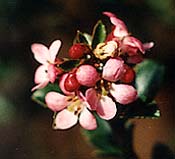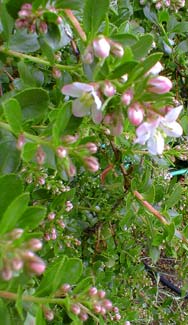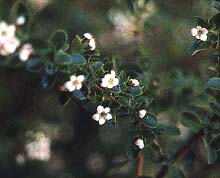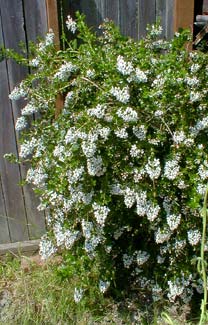 Apple Blossom Escallonia
Apple Blossom Escallonia
"If you truly love Nature, you will find beauty everywhere."
-Vincent Van Gogh
(1853-1890)
(1853-1890)
Escallonia langleyensis has small round evergreen leaves with rapid growth to five or six feet, or even larger. It can be trained by careful pruning into a compact shrub, but we've let ours go largely unpruned for an intentionally wild appearance.
 It grew well & swiftly & became quite a tangle of stems, yet for several years remained compact even without pruning.
It grew well & swiftly & became quite a tangle of stems, yet for several years remained compact even without pruning.Reportedly it becomes leggy if never pruned, but that has never been our experience; it has shown only the least tendency to lankiness; but when heavily flowered & after a rainfall, the tall shrub can droop a bit under the extra weight.
I'd long pondered attaching it with garden twine to the wooden fence it is beside, but the lean was never extreme or lasting, so I just let it do as it pleased for many years. But then a heavy snow weighted it down more than ever had happened & it did not pop back up entirely, so I did finally tie it upright. It could just as easily have been pruned back to start anew, though.
And indeed, eventually (in 2008) it did get a little floppy & spread wide enough to impinge on a nearby gate. And because we waited years to give it more than the most superficial pruning, it was difficult to clip it back without leaving some "bare" spots (of the less densely leafed interior of the shrub), & that was not as attractive as one might hope. Happily it regrew new limbs so swiftly it soon regained a nice full & compact look, so we assess it as very forgiving of an inartistic pruning. The best time for pruning is autumn after flowers become scarcer, or at winter's end just before it begins new growth. But if the pruning is done a bit earlier, in August, that would be the ideal time to save the pruned limbs, dip them in a rooting hormone, & put them in greenhouse pots of sandy soil, or in the ground under coldframes, resulting in as many new shrubs as anyone's little heart could desire.
As this shrub grows rapidly even from starts, it would be a good choice for a hedge. If pruned much more regularly than ours it has topiary possibilities & very easily hedged.
The lowest limbs sometimes become semi-creepers, forming a little carpet under the main shrub. This can look quite pleasing, but if it's not what you desire, these creeping bits are easily clipped away. These will also self-root along the ground, so can be put immediately into pots (ideally in summer). The next spring, when it's certain they are thriving, they can planted out in the gardens or given as gifts.
 Though it is often described as a summer bloomer, & indeed is floweriest June & July, ours gets a few scattered mildly aromatic blossoms on it in January which gradually increase in number, & does not entirely quit blooming until autumn.
Though it is often described as a summer bloomer, & indeed is floweriest June & July, ours gets a few scattered mildly aromatic blossoms on it in January which gradually increase in number, & does not entirely quit blooming until autumn.The flowers occur sometimes as solitary blooms, elsetimes in clusters, phasing in & out with a great many blooms then only a few. The flower close-up at the top of the page is from March (2002). The second photo is from May (2003). The third photograph is from July (2002) & the fourth is from June (2003), this last showing so thickly covered with tiny white blooms that the whole shrub shows signs of being weighted down, this predating the tie-back to the fence.
 Escallonias are native of South America, from Columbia to Brazil to Chile. There are several species ranging from small to medium sized shrubs, on up to escallonia trees. They are mostly evergreens. They are named for 18th Century Spanish traveler & plant hunter Antonio Escallon.
Escallonias are native of South America, from Columbia to Brazil to Chile. There are several species ranging from small to medium sized shrubs, on up to escallonia trees. They are mostly evergreens. They are named for 18th Century Spanish traveler & plant hunter Antonio Escallon. The species we have, E. langleyensis (Langley's Escallonia), refers to the place in British Columbia where it was first hybridized in 1893, for it is not a true species, but is a cultivated cross of red-blossoming E. rubra with white-blossoming E. virgata. The species can be a little fragile if sustained winter temperatures fall into the teens F., but because 'Apple Blossom' was developed in British Columbia, it is one of the sturdiest throughout the coastal areas of the Pacific Northwest.
The range of color reflected in these photographs is accurate. The pink buds in summer open to pure white, as would the flowers of E. virgata. But as seen in the first & second photos, the blossoms in autumn, winter, & spring, though fewer, are slightly larger, with much richer rosy hues, revealing its relationship to E. rubra.
I can only guess that the difference in color is temperature-related, pink in cool weather, white in warm weather. Or, white summer flowers wear out sooner in the heat, whereas the long-lasting flowers of the chilly-season increase in depth of color as they age.
'Apple Blossom' is this hybrid's best-known of many cultivars. It is usually described as pale pink, so our seasonal color changes for it may not be true of all specimens.
There are other varieties with blooms that are more definitively peach colored, or white, or red, & some cultivars have each blossom twice the size as 'Apple Blossom.'
Frankly many improvements have been made since 'Apple Blossom' was developed, & if we'd known more about them a decade ago, we might've gotten one of the red-flowering cultivars with bigger blooms. The most popular pink variety is E. x exoniensis 'Fradesii' also known as 'Pink Princess.' They all have that look of something traditional our grandmothers would've grown, because they are in fact shrubs our grandmothers might've grown.
But I don't want to sound like we regret the old 'Apple Blossom' standard, as it has been reliably trouble-free, strongly evergreen, fills a little corner outside the sprinkler range where other plants would not do as well.
It likes a lot of sun. It is tolerant of a wide range of conditions just so long as it isn't terribly alkaline, too wet, or too shaded. It is drought-hardy when established, but may be flowerier in most areas with regular watering in well-drained soil.
It ought to be fertilized at the very least once a year in early spring, though if completely neglected it'll still do well. Escallonia can even stand up to salt spray in coastal gardens. They are not fond of hot climates or long-sustained freezing winters, however, preferring temperate zones.